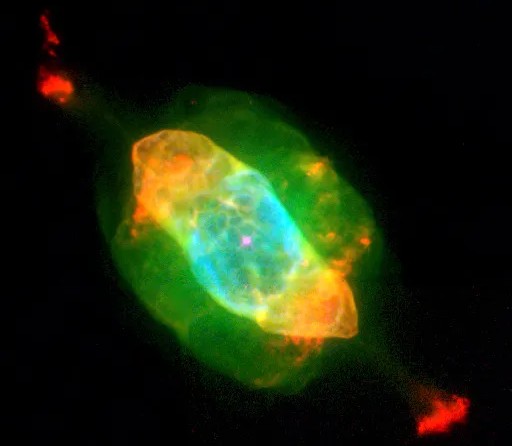The Saturn Nebula, also known as NGC 7009 or Caldwell 55, is a fascinating planetary nebula located in the constellation Aquarius, approximately 2,400 light-years from Earth. It was discovered by William Herschel in 1782. The nebula earned its name from its visual resemblance to the planet Saturn, particularly its “ringed” structure, as seen through early telescopes. This resemblance is created by the bright central region and faint extensions that appear like Saturn’s rings.
Physical Characteristics
NGC 7009 is a classic planetary nebula, formed from the expanding shell of ionized gas ejected by a dying star during the late stages of its life. The central star responsible for ionizing this gas is a white dwarf, the hot, dense core of the original star. What sets the Saturn Nebula apart is its complex structure, which includes knots, jets, and multiple shells. This intricate formation may be influenced by the presence of a binary star system at its centre, though this hypothesis is still being explored, as well as interactions with the surrounding interstellar medium.
Appearance and Structure
NGC 7009 appears as a bright, elliptical or hourglass-shaped nebula, with an overall diameter of approximately 0.3 light-years. Its distinctive, multi-layered appearance includes concentric shells and faint outer lobes, sometimes referred to as “ansae,” which resemble the handles or extensions seen in Saturn’s ring system. These ansae are likely the result of fast-moving gas expelled from the central star. The central, brighter region of the nebula contains a more condensed structure, surrounded by these fainter, more diffuse extensions that gradually fade into space.

Composition
The spectrum of the Saturn Nebula is rich with emission lines, primarily from ionized hydrogen (H-alpha) and doubly ionized oxygen (O III). These two elements dominate the nebula’s visible light, with the O III lines contributing to the nebula’s characteristic blue-green hue. Additional elements, such as helium, nitrogen, and sulphur, are also present in varying degrees. The emission lines result from the excitation of these gases by the intense ultraviolet radiation from the central white dwarf, giving the nebula its glowing, colourful appearance.
Evolutionary Stage
NGC 7009 is a representation of the late stages of stellar evolution for a low to intermediate-mass star, similar to our Sun. After burning through its nuclear fuel, the star ejected its outer layers, creating the nebula we see today. The central white dwarf, which is the remaining core, is incredibly hot and emits radiation that causes the surrounding gas to glow. Over time, the nebula will continue to expand and disperse into the interstellar medium, enriching it with heavier elements. The white dwarf itself will gradually cool and dim over billions of years, eventually becoming a black dwarf.
Planetary nebulae like the Saturn Nebula provide astronomers with valuable insights into the late stages of stellar evolution. By studying their spectra and composition, scientists gain a deeper understanding of how stars contribute to the chemical enrichment of the galaxy. These objects help trace the recycling of material between stars and the formation of new stars and planets, including elements heavier than hydrogen and helium.
Observation
The Saturn Nebula is a favourite target for amateur astronomers due to its relatively high surface brightness and unique, ring-like structure. It can be easily observed using small telescopes or even binoculars under dark skies, though larger telescopes will reveal more of its intricate details, including the bright central region, outer lobes, and ansae. The nebula’s blue-green colour is striking, especially through moderate to large telescopes, and adds to its appeal for observers.
Due to its location near the celestial equator in the constellation Aquarius, NGC 7009 is visible from both the Northern and Southern Hemispheres. The best time to observe it is during the months of July, August, and September, when Aquarius is high in the sky. This makes summer in the Northern Hemisphere and winter in the Southern Hemisphere the ideal times to view the Saturn Nebula. During these months, NGC 7009 is high above the horizon, offering clear, extended viewing opportunities for stargazers worldwide.




